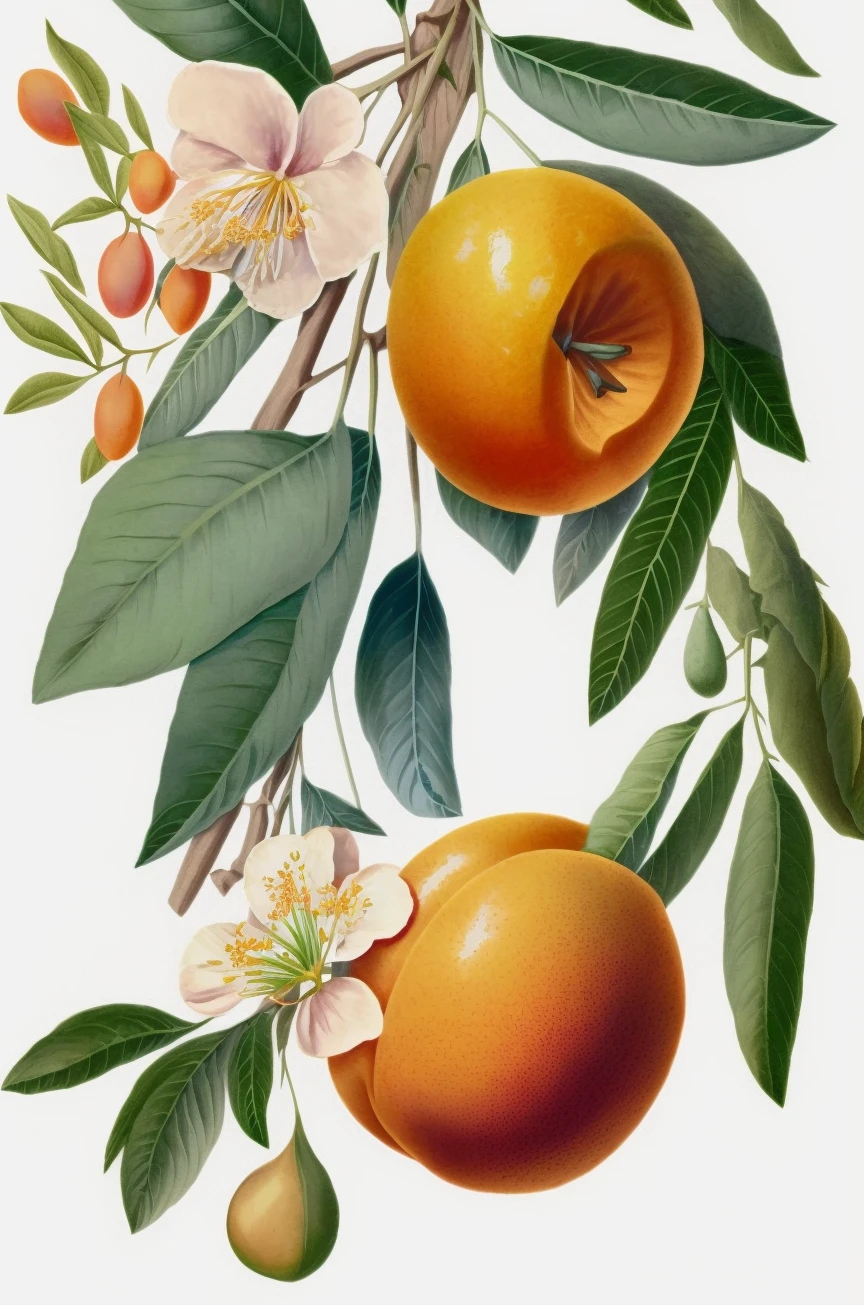We analysed 55,000 SEO articles and 4,000 SEO authors to map the gender gap in SEO publishing over the last 25 years.
The results might (not) surprise you.
Download our Gender Gap ebook here.
As the SEO industry continues to evolve, there is a growing awareness of the need for diversity and inclusion in the field. Despite this recognition, historical data reveals that there has been a significant gender imbalance in SEO publishing, with men dominating the industry since its inception. This study aims to provide a historical review of SEO publishing, analysing data to diagnose issues and offer solutions for moving forward. By shedding light on the industry’s past and present, this study hopes to contribute to the ongoing conversation about the need for greater diversity and inclusivity in SEO and beyond.
A history of male dominance in SEO publishing
Given that many early posts on the topic of SEO have disappeared or did not use the language and terminology that has now become industry standard, it is challenging to determine the exact first post on the subject. We’ve dug deep, and the oldest surviving SEO post we’ve found was written by Danny Sullivan, a white male, in 1997 for his portal Search Engine Watch. Twenty years later, Sullivan has grown from being an industry pioneer to a prominent figure within the SEO world. Despite the evolution of the industry, it is noteworthy that even today, 71% of the authors who write on this site are men.
The same gender imbalance that characterises Search Engine Watch history is present in the SEO industry as a whole. The data irrefutably shows that the SEO publishing field has been primarily dominated by white men since its inception. These men founded the companies, blogs and news sites that still dominate our industry, and they would turn to other men for guest blogging. As a result, 71% (or 7 out of 10) of all SEO authors have historically been men, and they have written 73.5% of all content in the industry.
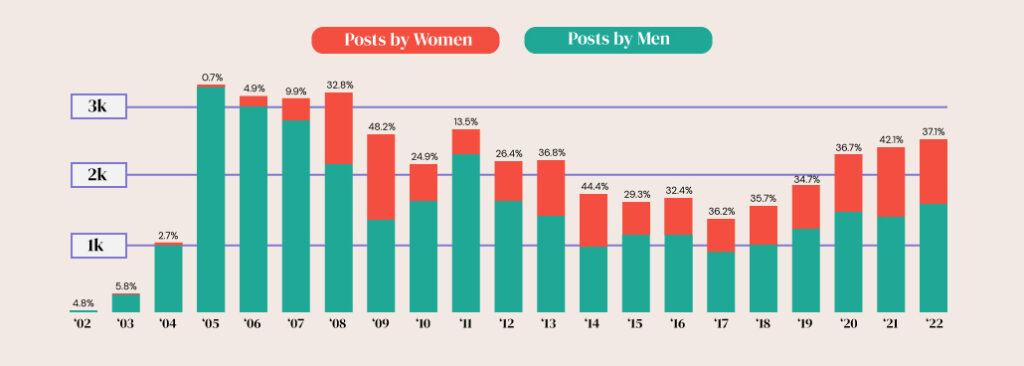
Starting from Sullivan’s industry-first SEO post (that we could find) in 1997, it’s revealing to know that it took a further 4 years for a woman to publish the first SEO article, and it was not until 11 years later that women accounted for 1 in every 10 posts written about SEO. In the 25 years since SEO has been written about, women have never published as much as men in any given year, and the closest the industry has come to gender parity has been in 2009.
Despite the historical gender imbalance in the SEO industry, there is room for optimism. Some publications are now taking the gender gap seriously and creating spaces for women to produce content at the same rate as men. At the same time, individual female SEO professionals have carved their own spaces in the industry, resulting in parallel power structures.
With this study, we want to give the first historical review of SEO publishing, use the data insights to diagnose some of the issues within the industry and provide ideas for driving the industry forward. The study was driven by a fundamental question: how much progress has the industry made, and how much work remains to be done? The answer, unsurprisingly, is “not far enough and quite a lot”.
This is by no means the first foray into gender diversity in SEO publishing. Lidia Infante has been making waves with her analysis of the gender gap in the industry since 2021, and The Freelance Coalition recently published a great study on racial gaps in the industry. In this context, this study is one more voice joining the emerging chorus of voices calling for change. The data seems to tell a simple story: it’s about time.
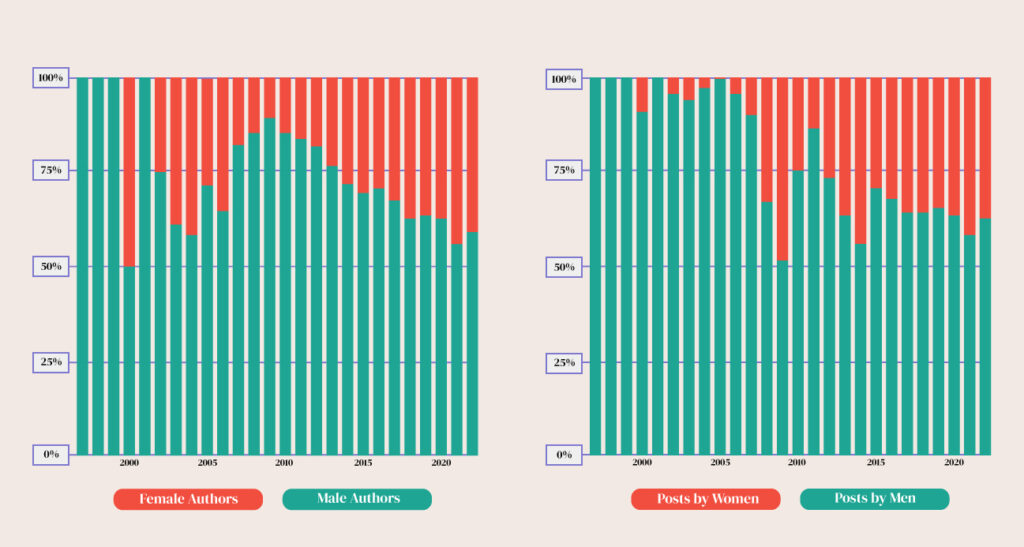
How far have we come?
In the past decade, there has been a significant increase in the percentage of women publishing SEO content, which has stabilised at around 40%. This growth is a considerable improvement compared to 2009, when only 11% of authors were women. However, recent data from 2022 shows a slight decrease in the number of women writing in the industry, with a drop from 44% to 41% (from 212 to 198).
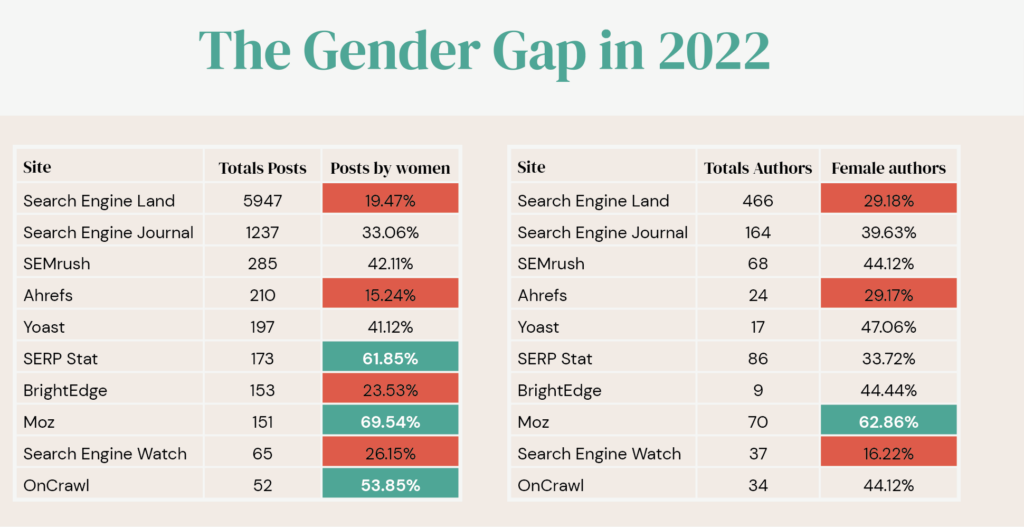
The results are slightly worse if we look at the amount of published SEO content officially authored by women. In 2022, only 37% of content was written by women, down from 42% in 2021. So not only are fewer women writing in the SEO industry than the previous year, but the ones who are, are also writing less.
This highlights another challenge facing the SEO industry: not only is it difficult to attract women into the industry, but it is even harder to retain them once they are there.
Women are seizing the means of SEO publishing
The lack of diversity in the early days of the SEO industry gave an advantage to the male pioneers who, for the most part, still hold influential positions today. These predominantly-male early movers produced far more content than their female counterparts and created homogeneous communities that exacerbated the situation. As a result, the SEO publishing field experienced a decade of lost opportunity: in 2007, 10 years into SEO content production, the industry published a total of 3,150 posts, of which only 313 were written by women.
Not only there are fewer women publishing in SEO, but, on average, they also write fewer posts than men. Women’s average sits at 10.6 posts, while men write 11.9 posts each. This is further exacerbated by the fact that 9 out of the 10 most prolific authors in the industry (super-posters) are men, and they have collectively written more than 1 in every 3 posts. The only woman to make it on the list is Nathania Johnson, who contributed 2,170 posts in 3 years, but her last contribution was in 2010. This lack of representation highlights the need for greater diversity and inclusion in the SEO industry.
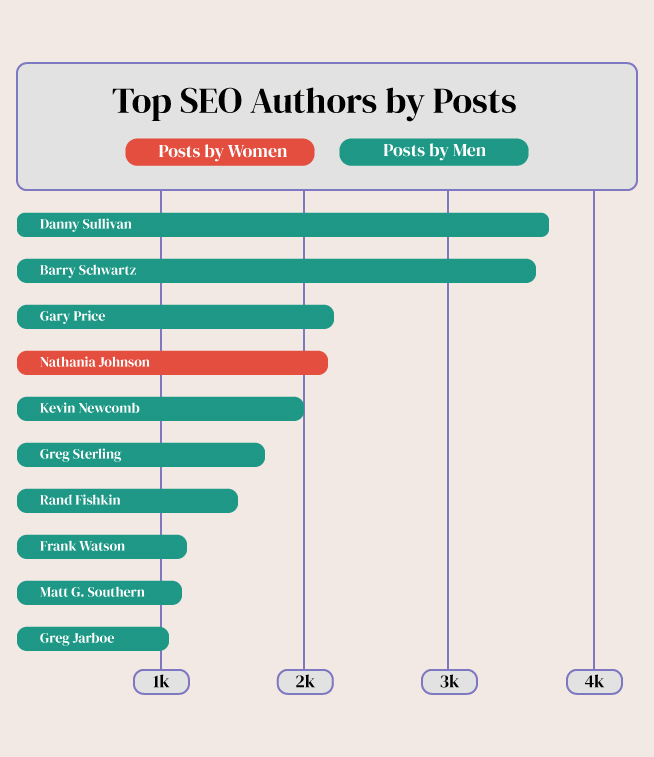
Despite the gender gap and lack of diversity in the SEO industry, some women have taken the initiative to create their own spaces and carve out a niche for themselves. Aleyda Solis, for example, has become the go-to expert for international SEO and created the most followed mailing list in the industry. Areej AbuAli has founded Women in Tech SEO, a global network of women in SEO that doubles as both a support system and a mentoring group. Meanwhile, Mary Haynes has become an institution within the field of EEAT and, along the way, one of the most respected professional in the industry. These women are just a few examples of the many who have created their own websites, tools, communities and companies.
Others participated in these early institutions and thrived there. Sarah Bird, for example, led Moz after Rand Fishkin’s resignation and, under her guidance, shaped it to become the only site we’ve encountered for this study, with a majority of posts published by women in 2022. Amanda Zantal-Wiener became the editor-in-chief at Search Engine Journal after taking the mantle from Miranda Miller. Marieke van de Rakt rose to become the Head of Strategy at Yoast.
The work of these women has been vital in advancing the SEO industry. Through their publications, tools, and communities, they have brought much-needed diversity and fresh perspectives to the field. They have also paved the way for future generations of women in SEO, inspiring them to pursue their passions and make their mark on the industry.
An industry moving at different speeds
The success of these women in the SEO industry is a testament to their hard work and perseverance, despite the challenges they have faced. However, it also highlights the difference that sites and companies can make to the issue if they take a proactive approach.
In our analysis of the top 11* SEO industry sites, only 1 had more female authors than male authors, and only 3 had more posts written by women.
Last year MOZ, SERPStat and OnCrawl were the top performers. While MOZ had an encouraging 70% of female authors and 63% of posts written by women, SERPStat and OnCrawl had more women than men in their writers’ staff (62% and 54%, respectively), but they weren’t as active, so the overall number of posts authored by women is lower at 34% and 44% respectively. This suggests that programs to promote gender parity in the writing room are effective, as is having women in leadership positions. However, safeguards are necessary to ensure that author diversity translates into posts’ diversity.
Some of the worst-performing sites in terms of author diversity are Ahrefs (15% of posts written by women), Search Engine Land (19%) and Search Engine Watch (26%). These sites are also the worst performers in terms of post diversity, although the stats do look a litter better on that front as both Ahrefs’ and Search Engine Land’s women on staff have a higher output per head, lifting the percentage of posts written by women to 29%.
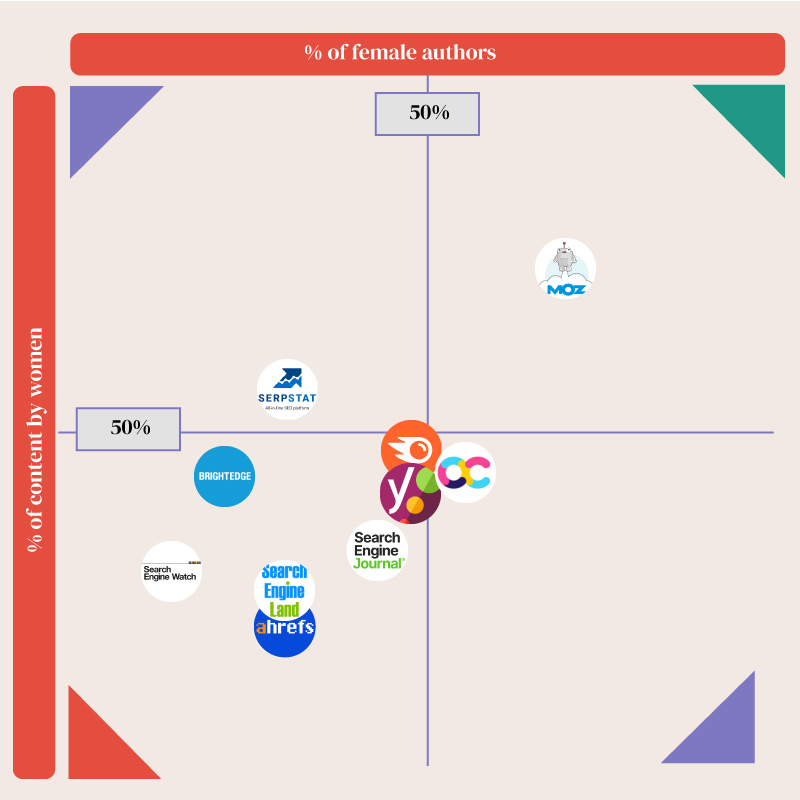
If other sites could match MOZ’s speed, where 7 of 10 posts are written by women, would that lead to gender parity in the SEO publishing world? While it would help righten the gender imbalance, historical data suggests that it may not be enough. Although MOZ has made significant progress since 2020, with 70% of their posts now being written by women, the finish line is still far away. If we consider the data from 2004, when their first 5 posts went live, men still account for 76% of all posts published on the site. Even with their current speed and being a rare example within the industry, it will take MOZ some time to erase a decade of an almost exclusively male SEO industry from 1997 to 2007.
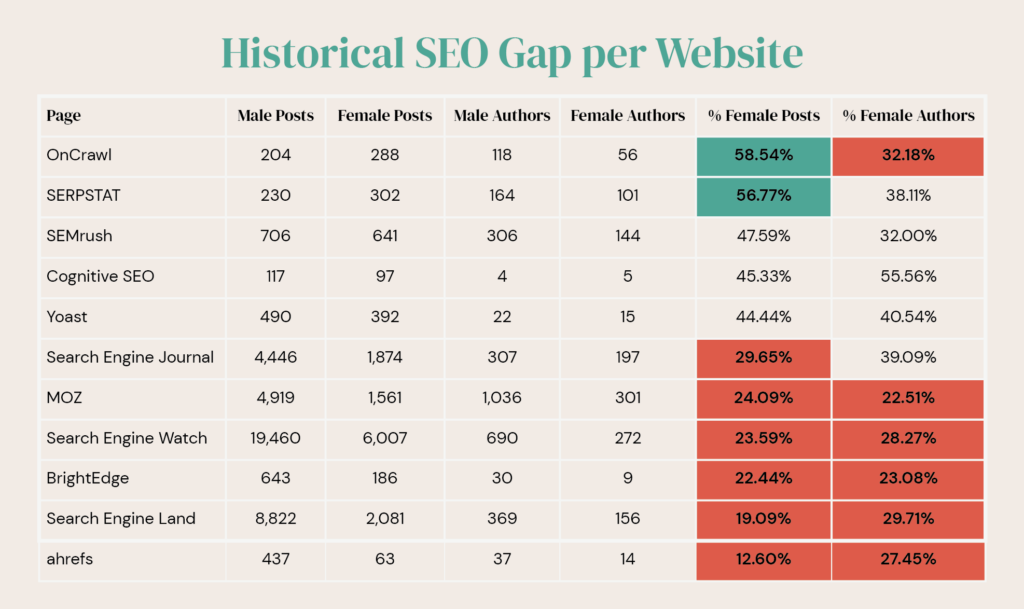
Where to go from here
In Lidia Infante’s blog post about the gender gap in the SEO industry, she provides 4 key recommendations to bridge the gap: widen the pool of female writers, connect with more women in SEO, follow people who promote women’s voices and make the pitching process transparent.
While doing our research and conversations with female SEO authors, we consistently heard that gender was not the primary issue they faced. Many of the top female authors in the industry, some of whom left more than a decade ago, spoke of poor management and toxic communities, but stressed that they did not perceive gender as a discriminatory factor and that they had equal opportunities as their male counterparts.
We heard, instead, of visibility. The organisations most successful at bringing diversity to their writing spoke about self-perpetuating cycles, and how an industry with a male-dominated start is likely to attract people with similar profiles. We didn’t hear about an industry hostile towards women, but instead, how it requires intentionality to break the cycle and provide opportunities to people with backgrounds, ethnicities, gender identities and writing styles different from the monolithic one that preceded them.
It is heartening to discover that there are inspiring stories of a supportive and empowering community of women in the SEO industry. Despite the challenges, we have come across leaders and editors who have gone above and beyond to create safe and welcoming spaces for women. It is heartening to see women looking forward to industry events to catch up with a growing number of female experts and forming friendships that have lasted more than two decades around the ups and downs of search engine optimisation.
While the SEO industry still has a long way to go in achieving gender parity, the progress made by individuals, companies, and the industry as a whole is evidence that change is possible and that, together, we can continue to create a more inclusive and equitable industry for everyone.
Notes on Methodology
We reviewed 11 of the top SEO blogs in the market and tracked every single article and author, extracting the percentage of male and female writers by year.
We reviewed more than 55,000 posts from almost 4,000 different authors and gained some valuable insights into the current state of the gender gap in our industry, plus the work we still need to do to make SEO publishing a more inclusive space for everyone. Some things to note are:
- When it came to selecting which blogs to review, we opted for a quality-first approach. Rather than trying to cast our net as wide as possible, we focused on analysing the most authoritative and well-known blogs and websites within the SEO industry.
- In the interest of time and resources, we’ve had to exclude the countless smaller blogs out there.
- We used everyone’s new best friend, ChatGPT, to identify the gender of the authors.
- Any posts published by brands or multiple people were excluded from the data set to ensure accuracy.
- Search Engine Journal was left out of our over-time calculations due to their habit of republishing posts.
- We’ve also removed CognitiveSEO from the individual website metrics, as they had only 5 posts and 2 authors in 2022.
A heartfelt thank you to
Nathania Johnson, the most prolific woman in SEO publishing, who in 2009 got SEO publishing the closest it’s been to gender parity by writing 1,138 posts.
Lidia Infante, for paving the way in gender and diversity research in SEO publishing.
Kayle Larkin & Danielle Escaro, who had more patience that we were owed sharing their experiences and educating us on this topic.
Sara White, Georgia Booker and Claudia McKenzie for their support in writing, proofreading and vibe-checking this document.
Sandy Nguyen and Leonardo Gallina, for their technical support in crawling, scrapping and categorising a lot of information.
To you. For taking the time and effort to go through this. For reading it, sharing it and being part of the conversation.

